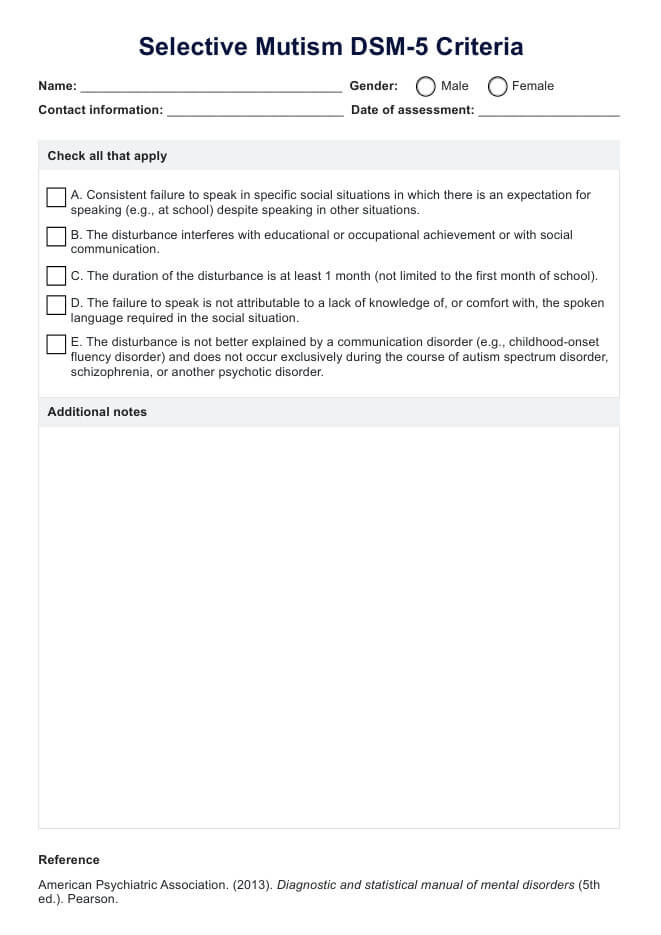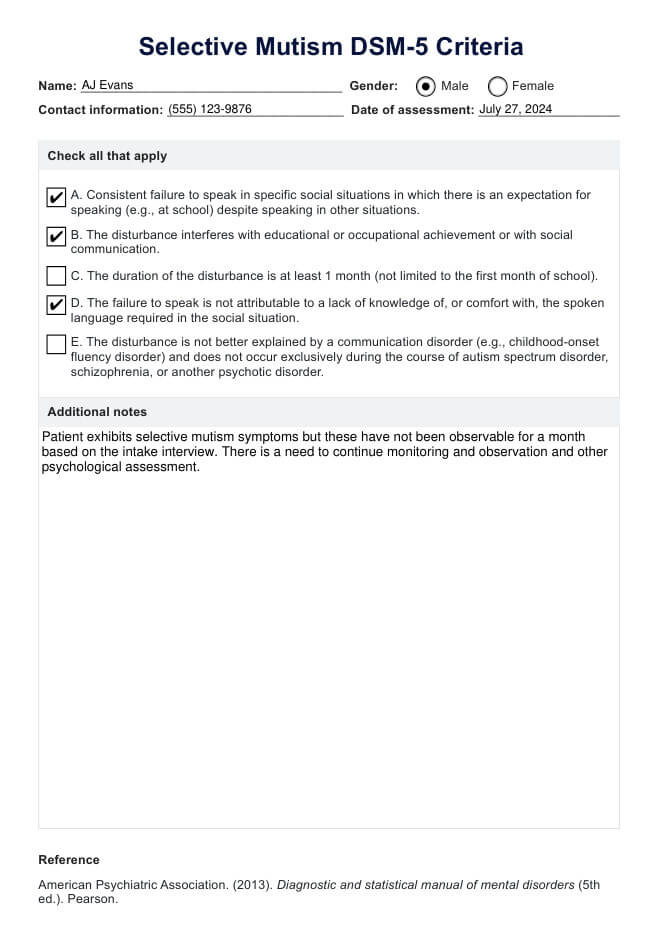Selective Mutism DSM-5 Criteria
Understand Selective Mutism DSM-5 Criteria with our handy resource. Download a PDF copy here.


What is selective mutism?
Selective mutism is a complex anxiety disorder that primarily affects children. This is characterized by a consistent failure to speak in specific social situations despite having the ability to speak in other settings (American Psychiatric Association, 2013). This condition can significantly impact a child's educational or occupational achievement and social interactions, making early identification and intervention crucial.
Selective Mutism DSM-5 Criteria
Selective Mutism DSM-5 Criteria
How is selective mutism diagnosed?
Selective mutism is diagnosed based on the criteria outlined in the Diagnostic and Statistical Manual of Mental Disorders, Fifth Edition (DSM-5). The key feature is a consistent failure to speak in specific social situations where speaking is expected, despite the ability to speak in other settings (American Psychiatric Association, 2013).
To make a diagnosis, healthcare providers typically:
- Conduct clinical interviews with the child, parents, and teachers
- Observe the child's behavior across different settings
- Use standardized assessments, such as the Selective Mutism Questionnaire (SMQ)
- Perform a language evaluation to rule out communication disorders
- Assess social skills and emotional functioning
It's crucial to differentiate selective mutism from other conditions like autism spectrum disorder or a possible communication disorder. Other anxiety disorders, such as social anxiety disorder or social phobia and generalized anxiety disorder, must also be ruled out. The symptoms must persist for at least one month and interfere with educational, occupational, or social functioning.
More importantly, the failure to speak should not be due to a lack of knowledge of the required language or occur exclusively during other mental health conditions. Early identification and diagnosis are vital for effective intervention and improved outcomes for children with selective mutism.
Selective mutism DSM-5 diagnostic criteria
The DSM-5 provides specific criteria for diagnosing selective mutism, a complex anxiety disorder that typically manifests in childhood. Understanding these criteria is crucial for accurate diagnosis and effective treatment planning.
According to the DSM-5, the diagnostic criteria for selective mutism are:
- Criterion A: Consistent failure to speak in specific social situations where there is an expectation for speaking (e.g., at school) despite speaking in other situations.
- Criterion B: The disturbance interferes with educational or occupational achievement or with social communication.
- Criterion C: The duration of the disturbance is at least 1 month (not limited to the first month of school).
- Criterion D: The failure to speak is not attributable to a lack of knowledge of, or comfort with, the spoken language required in the social situation.
- Criterion E: The disturbance is not better explained by a communication disorder (e.g., childhood-onset fluency disorder) and does not occur exclusively during the course of autism spectrum disorder, schizophrenia, or another psychotic disorder.
We have outlined these diagnostic criteria in our PDF resource, formatted with fillable checkboxes and space for additional notes to also serve as a handy reference tool in your clinical practice.
How is selective mutism treated?
Treating selective mutism typically involves a multifaceted approach tailored to each child's unique needs and circumstances. The primary goal is to reduce anxiety and gradually increase verbal communication in various social settings. The following approaches are typically taken to treat selective mutism:
Cognitive-behavioral therapy (CBT)
Cognitive-behavioral therapy is often the first-line treatment for selective mutism. CBT helps children identify and challenge anxiety-provoking thoughts while developing coping strategies. Exposure therapy, a component of CBT, involves gradually exposing the child to speaking situations, starting with less anxiety-inducing scenarios and progressing to more challenging ones.
Social communication anxiety treatment (S-CAT)
Social Communication Anxiety Treatment (S-CAT) is another effective approach. It combines behavioral techniques with anxiety reduction strategies, focusing on nonverbal communication before progressing to verbal communication.
Family involvement
Family involvement is crucial in treating selective mutism. Parents and siblings are often trained to use specific techniques at home, such as positive reinforcement and avoiding speaking for the child.
School-based interventions
School-based interventions play a vital role, as many children with selective mutism struggle most in educational settings. Collaborating with teachers to create a supportive, low-pressure environment can significantly aid progress.
It's important to note that treatment often requires patience and persistence. Progress may be gradual, but with consistent effort and a supportive environment, many children with selective mutism significantly improve over time.
Reference
American Psychiatric Association. (2013). Diagnostic and statistical manual of mental disorders (5th ed.). Pearson.
Commonly asked questions
The diagnostic process typically involves clinical interviews with the child, parents, and teachers, behavioral observations across different settings, standardized assessments, language evaluations, and social skills and emotional functioning assessments.
It is crucial to differentiate selective mutism from other conditions like autism spectrum disorder, communication disorders, and social anxiety disorder. The symptoms must persist for at least one month and interfere with educational, occupational, or social functioning. The failure to speak should not be due to a lack of knowledge of the required language or occur exclusively during other mental health conditions.
Traumatic mutism involves the complete inability to speak in all situations following a traumatic event, whereas trauma-induced selective mutism involves the inability to speak in certain situations that are reminiscent of the trauma, while the individual can still speak in other settings. Selective mutism, as an anxiety disorder, maybe a consequence of difficulty processing trauma, but it is not exclusively caused by trauma.





















-template.jpg)


















































































